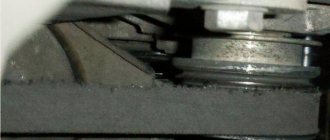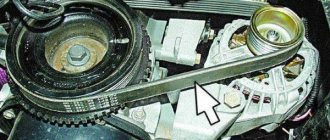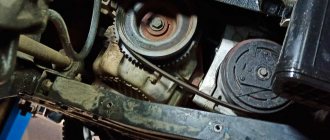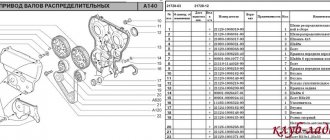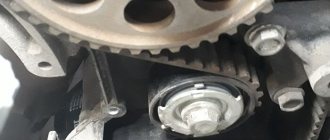The VAZ 2114 timing belt is installed on an 8-valve and 16-valve engine. The belt performs the function of transmitting torque from the crankshaft to the camshaft of the internal combustion engine, reducing the speed of the latter (necessary for the supply of fuel and the correct mode of gas removal as a result of the cyclic movement of valves and pistons).
The belt also drives the pump (water pump), which is responsible for the cooling system. In this case, problems with the belt lead to the valves stopping, which can result in their bending (for example, in 16-valve engines) from impact with the pistons.
To avoid such a problem, it is necessary to monitor the condition and periodically replace the VAZ timing belt according to regulations, namely every 50-60 thousand kilometers. Next, we will look at how to replace the timing belt on a VAZ 2114.
What are the consequences of incorrect timing belt tension for the VAZ-2114 engine?
The timing belt has almost slipped. Pay attention to the gap from the belt to the engine, it is uneven
If the belt is significantly displaced, a picture similar to its complete break may be observed. Therefore, it is necessary to pay serious attention to the correct tension of the timing belt, both when replacing it and during operation of the vehicle. You can do this yourself, but be careful and be sure to follow the instructions below.
Proper tension (order and process)
Before you begin tensioning the timing belt, you must turn off the engine after idling in neutral gear. In this case, the engine crankshaft will stop in a position where all the forces acting on it will be balanced. Now let's start tensioning.
- Remove the belt protective cover.
The casing has been removed. We inspect the belt
Video of replacing and tensioning the timing belt on a VAZ-2114
Consequences of incorrectly setting timing marks
If the ignition is set incorrectly, the following negative aspects are possible:
- If the engine has 16 valves, then they become deformed or bent during operation, accumulating damage.
- The previous problem causes damage to the cylinder head.
- The guide bushings may also become unusable.
- Cracks may appear in other engine components.
Crack in the cylinder block
- The motor overheats.
- The engine piston mechanism can burn out.
- Oil residue may appear on the spark plugs.
Oil deposits on spark plugs
- The fuel mixture loses its ignition moment.
Note! If the engine has 8 valves, then the consequences are not so critical - traction disappears, the belt quickly wears out and breaks.
After repairs, the following factors most often indicate an incorrectly set ignition:
- The car accelerates worse.
- Frequent overheating of the motor.
- The craving became much worse.
conclusions
Incorrect timing belt tension will lead to accelerated wear.
Accelerated wear of the timing belt due to incorrect tightening.
The engine on a VAZ-2114 does not bend the valve when the timing belt breaks, but still, there is a risk of getting up at night in a dark field in our big country. You will be lucky if the belt breaks at home or at work, and not on a long trip. To prevent this from happening, you need to set the timing belt correctly, as we wrote above!
Source
Common mistakes
It sometimes happens that after the timing belt has been replaced, the part begins to whistle. In fact, it is not the belt that whistles in this way, but only the roller, which also needs to be replaced.
If you noticed that several teeth on the old belt were torn off at the same time, it is likely that the cause of this malfunction was a jammed pump. Therefore, it is worth checking this part and, if necessary, replacing it.
By following all the above tips, you can quickly and without any problems replace the timing belt on a VAZ-2114, ensuring normal engine operation for a long time.
Replacing and checking the timing belt in Lada Granta
Adjusting valves on a VAZ-2110 - work progress and useful tips
How to adjust valves on a VAZ 2106, sequence and diagram for checking thermal clearances
Quick replacement of the timing belt on a VAZ 2114 with an 8-valve engine
Today I came to visit my old friend, barbecue and all that, and in between, a small maintenance on his freshly painted VAZ 2114, replacement of the timing belt, rollers and pump. This car has a standard eight-valve engine and this greatly simplifies the matter, since on this engine the procedure for replacing the timing belt takes 30 minutes. In our case, the timing belt was eating up a little on the inside and one of the oil pump bolts was to blame for this, we’ll talk about this at the end of the article.
On the VAZ 2114 engine there are 8 valves, if the timing belt breaks, the valve does not bend.
Under standard conditions, the timing belt replacement interval is 60 thousand kilometers or four years of operation, whichever comes first. The replacement interval can be increased to 80 thousand with periodic monitoring of the condition of the belt, roller and pump.
Stages of work
Replacement is quite simple, you just need to remove the installed part and put a new one in its place, making sure that there are no defects on it that could interfere with normal operation. But both dismantling and replacing the strap with a new one must be carried out in strict accordance with the instructions.
Preparation
Before the replacement procedure itself is carried out in the VAZ-2114, you need to turn on the handbrake and also set the lever to fourth gear. This is done in order to ensure not only safe, but also convenient performance of all work, since otherwise carrying out all work will be quite difficult.
Removing the old timing belt
- Remove the cover, which protects the parts from external factors, and then remove the drive belt.
- Next, you should carefully remove the crankshaft drive pulley, without touching the mounting bolt, and then switch the lever to neutral gear.
- Carefully rotate the crankshaft clockwise, constantly paying attention to the current condition of the flywheel and the marks, which can be seen through the special hole in the clutch housing. You need to move the crankshaft until the mark is in line with the middle strip of the scale.
- Once the mark is exactly parallel to the one at the back, you should unscrew the tension roller mounting nut in order to later remove the used belt.
Install a new belt and tension it
- The new belt, to which the used part is replaced, is put on the camshaft pulley, after which both of its branches should be sufficiently tensioned.
- The left part, which remains loose, should be placed behind the roller, then put it on the crankshaft and pump pulleys, and then constantly turn the roller counterclockwise until you are absolutely sure that the timing belt is fully tensioned.
- The crankshaft is rotated approximately one and a half to two turns, after which the repairman must make sure that both marks are in the middle. If, after performing the replacement, it turns out that the marks do not coincide with each other, you need to remove the timing belt again and repeat all the above operations again, and do this until both marks are parallel to each other.
- If everything is correct, the crankshaft bolt should be removed, and then the generator pulley should be returned to the workplace, which should then be secured with the bolt.
- Tension the belt and return the generator drive belt by turning the special roller counterclockwise.
Ultimately, after replacing the timing belt on a VAZ-2114 is completed, you need to start the engine to make sure there are no problems. In addition, based on the sound, you can approximately understand how well the belt is tightened.
If something remains unclear, you can watch the video instructions for performing this operation on a VAZ-2114:
Step-by-step instructions for replacing the timing belt
- And one in front, remove the cover. Key for 10.
- Remove the generator drive belt. Loosen the locking nut, set the wrench to 13 and unscrew the tension bolt, set the wrench to 10. Move the generator towards the cylinder block.
Alternator belt tensioning mechanism.
- If you cannot move the generator, you need to loosen the fastening nut from below. The key is 17.
Generator mounting.
Set the top dead center
- We ensure that the mark on the camshaft toothed pulley (hereinafter referred to as simply an asterisk) matches the mark on the metal casing.
Camshaft mark.
- The mark on the crankshaft sprocket should also coincide with the low tide on the oil pump.
Crankshaft mark.
- We unscrew the crankshaft pulley bolt, having previously locked the crankshaft. We block the rear wheels, engage fifth gear and insert a screwdriver into the ventilation hole of the brake disc below the caliper. 17mm head with extension and pipe as a lever.
- Unscrew the nut securing the tension roller and remove it along with the old timing belt.
Fastening the tension roller.
Replacing the pump
Put one round of electrical tape around the camshaft, this will prevent you from losing a key!
Usually it gets very stuck, so a pry bar will help us here.
- Lubricate the pump gasket with a thin layer of sealant and install the pump in place. We install the protective casing and tighten all the bolts evenly.
Pump mount.
Replacement
To replace, you need to prepare a set of tools and you can get to work.
Step-by-step instruction
- To replace the belt, you will need to remove the front right wheel, this will provide more convenient access to the gas distribution mechanism;
- We unscrew the generator pulley, it is best to do this with a partner, who will engage 2nd gear and press the brake, and at this moment you unscrew the bolt securing the pulley to the crankshaft;
Rotate the crankshaft until the marks coincide;
- We install the generator pulley in place and start the engine;
- The belt tension should be moderate, the long part of the belt should rotate 90°, then the tension will be correct.
Installing a new timing belt
- We get a new timing kit, in our case from Gates.
Gates timing kit.
- For a VAZ 2114 engine with 8 valves, it contains a toothed belt and a tension roller.
- If anyone needs it, the article number on the box is as follows.
- We check that all marks match. We install the tension roller in place, but do not tighten the nut. Next, install a new timing belt, put it first on the crankshaft sprocket, then on the camshaft sprocket, tension roller and pump. We make sure that the descending branch of the belt is tensioned.
- Using a special wrench, turn the tension roller and tighten the timing belt. Tighten the nut.
- The correct tension is considered to be one in which, with two fingers, we can turn the timing belt in the longest section by a maximum of 90 degrees.
A new timing belt has been installed.
- We install all parts in the reverse order of removal. Fill with antifreeze.
This procedure is so simple that you can do it yourself even without a garage, just in the courtyard of your house.
What is timing belt?
Timing mechanism diagram
The gas distribution mechanism is a mechanism in which the valve timing of the power unit is controlled. For normal engine performance, there are special marks by which the timing belt must be set.
Some are on the block, while others are on the pulleys. When the cylinder is in the first upper position, all these marks must coincide.
The timing marks are misaligned if the drive toothed belt is broken or if it is replaced incorrectly. So, in these cases, the engine will not work correctly and the marks will need to be re-set. Doing this is quite problematic and not everyone can do it.
Causes of toothed belt wear on VAZ 8 valve engines
- Wear of the timing belt on the front side is the main cause of a worn pump, but sometimes it can also be the tension roller stud and, in very rare cases, the camshaft sprocket. To eliminate this problem, replace the worn part.
- Wear on the rear side is much less common. The main reason is the bolt on the oil pump. Over time, the belt tension weakens a little and, vibrating, it begins to reach this bolt. It’s very easy to fix this problem; we replace the Torx sprocket bolt with a regular 10mm socket, its head is smaller and the timing belt is no longer missing. The photo shows wear from the belt.
When is replacement necessary and what is needed for this?
During the depreciation period, the timing belt begins to peel, tear or slip. If a breakdown occurs while the engine is running, it stalls and becomes impossible to start. When operating a VAZ 2114 with an engine equipped with an injection device for supplying fuel, an indicator on the instrument panel will light up, notifying you of a phase sensor error.
If the car is equipped with a 1.5 liter, 8-valve power unit, then the repair itself will only require the purchase and replacement of a belt. If a 1.3 liter engine is installed, this breakdown will lead to damage to the entire gas distribution mechanism. Major renovations will be needed. The timing belt replacement on a VAZ should take place after 45 thousand km of vehicle operation. Constant monitoring of the mechanism is necessary for the purpose of prevention. The sequence of actions is as follows.
- Purchase and replace the tension roller.
- Eliminate possible play in the pump.
- Lubricate the roller mechanism.
If you have simple plumbing tools, replacing the timing belt is possible at home. List of tools needed to repair the unit in question.
How to check and adjust the timing belt on a VAZ 2113, 2114, 2115
It is recommended to check the timing belt every 15,000 km during the next maintenance.
To perform this work, you will need a timing belt tensioner.
Using a 10mm wrench, unscrew the 3 bolts securing the front timing belt cover.
Lift it vertically up and remove it from the engine.- We turn the crankshaft and visually check the condition of the belt. The crankshaft can be turned with a 17 or 19 wrench using the pulley bolt. Visually the belt should be clean. If the belt shows signs of wear, cracks, or delamination, it definitely needs to be replaced.
Try turning the belt 90 degrees with two fingers. You need to pull in the area between the crankshaft and camshaft pulleys, applying a force of 15–20 N m (1.5–2.0 kgf m). If you can’t turn it, it means the belt is too tight. If the belt can be turned to a greater angle, it is loosely tensioned. Attention! The belt must be adjusted on a cold engine. An overtightened belt will shorten the life of the belt itself, the tension roller bearings and the coolant pump. Weak belt tension can cause the belt to jump over the camshaft teeth.- In order to check the relative position of the camshaft and crankshaft, you need to install the piston of the 1st cylinder at TDC of the compression stroke. For this:
a) It is necessary to remove the plug in the upper part of the clutch housing.
b)
In this window, use a screwdriver to turn the crankshaft by the teeth of the flywheel ring
until the mark on the camshaft pulley and the protrusion of the rear timing belt cover align.
In this case, the mark on the flywheel should align with the center of the scale.
If the relative position of the crankshaft and camshaft is disturbed, then turn the crankshaft until the mark aligns with the center of the scale. Loosen the belt tension and remove it from the camshaft pulley. Turn the camshaft until the mark on its pulley aligns with the protrusion on the rear cover. Without changing the relative position of the shafts, put the belt on the camshaft pulley and adjust the belt tension.
7. Use a 17 mm wrench to loosen the tension roller mounting nut.
8. By turning the roller with a special wrench, we adjust the belt tension and, holding the roller in this position, tighten the nut that secures it.
9. Check the belt tension (see above) and, if necessary, repeat the adjustment.
10. Finally tighten the roller fastening nut to a torque of 33.2–41.2
11. Reinstall the front belt cover and tighten its fastening bolts.
In conclusion
Correct operation of the timing system is the key to reliable and proper operation of the engine. Therefore, you should be very careful both in caring for this system and the belt, and in protecting it. Many domestic car enthusiasts like to drive without a protective cover, which should not be done under any circumstances if you do not want to reduce the replacement cycle by half.
Afterwards it should be tensioned correctly. Let's talk about this. Timing belt tension VAZ 2110, 2111 (8 cl.) To adjust the belt tension, turn the crankshaft counterclockwise so that the mark on the camshaft pulley moves down from the rear cover antenna by two teeth. Checking the timing belt tension means that the front branch of the belt is twisted 90° with the thumb and index finger of the hand with a small force of 1520 N (1.52.0 kgf). Here the questions arise: how to calculate the force? Everyone's finger strength is different, how to find the appropriate strength? It is necessary to tighten the timing belt so that at the longest section, try to turn it 90 degrees with 2 fingers; if you practically succeed, then the belt is tensioned normally. Try to tighten the timing belt and keep in mind that if the belt is too tight, you won’t be able to turn it 90 degrees with your fingers. if you didn't make it. the belt will dangle and hit the plastic casing (this should not happen). We tighten it until the sound disappears at idle and when accelerating. For this reason, if the timing belt is tensioned correctly, then when the casing is removed, its long part will fluctuate within 1cm. from the axis. Tensioning the timing belt VAZ 2112 (16 cells) Using a special wrench, tension the timing belt with a tension roller. If it is not there, then there is an option to tighten the timing belt using 2 nails and a screwdriver, which will be installed on them. There is also an option to transform a table fork into a suitable tool by breaking off 2.7 central teeth, and shortening and bending the last ones. Having turned the crankshaft two turns in the direction of rotation, we check the alignment of the installation marks. We check the tension of the toothed belt in the middle part of the branch between the camshaft pulleys. The belt deflection should be 5.4–0.2 mm. under a load of 100 N (10 kgf). And how to check the timing belt tension without a special tool? How do you figure out how much pressure you need to put on the timing belt? Method 1. Use 10kg. weights and ruler. Place a ruler on the belt between the pulleys, and a weight on the ruler. We pull so that the deflection from the plane is already 5mm. Method 2.4. Use steel scales. Attach the hook of the scale in the center of the belt between the pulleys and pull them upward until the reading on the scale is 10 kg. Then we measure the distance by which the timing belt has deviated (should be 5.4–0.2 mm). When, the same tool is used to tension the generator belt and nuts: Similarly with 8kl. motors: if you didn’t make it. the belt will dangle and hit the plastic casing.
How to check and adjust the timing belt on a VAZ 2113, 2114, 2115
It is recommended to check the timing belt every 15,000 km during the next maintenance.
To perform this work, you will need a timing belt tensioner.
- Using a 10mm wrench, unscrew the 3 bolts securing the front timing belt cover.
- Lift it vertically up and remove it from the engine.
- We turn the crankshaft and visually check the condition of the belt. The crankshaft can be turned with a 17 or 19 wrench using the pulley bolt. Visually the belt should be clean. If the belt shows signs of wear, cracks, or delamination, it definitely needs to be replaced.
- Try turning the belt 90 degrees with two fingers. You need to pull in the area between the crankshaft and camshaft pulleys, applying a force of 15–20 N m (1.5–2.0 kgf m). If you can’t turn it, it means the belt is too tight. If the belt can be turned to a greater angle, it is loosely tensioned. Attention! The belt must be adjusted on a cold engine. An overtightened belt will shorten the life of the belt itself, the tension roller bearings and the coolant pump. Weak belt tension can cause the belt to jump over the camshaft teeth.
- In order to check the relative position of the camshaft and crankshaft, you need to install the piston of the 1st cylinder at TDC of the compression stroke. For this:
a) It is necessary to remove the plug in the upper part of the clutch housing.
b)
In this window, use a screwdriver to turn the crankshaft by the teeth of the flywheel ring until the mark on the camshaft pulley aligns with the protrusion of the rear timing belt cover. In this case, the mark on the flywheel should align with the center of the scale.
If the relative position of the crankshaft and camshaft is disturbed, then turn the crankshaft until the mark aligns with the center of the scale. Loosen the belt tension and remove it from the camshaft pulley. Turn the camshaft until the mark on its pulley aligns with the protrusion on the rear cover. Without changing the relative position of the shafts, put the belt on the camshaft pulley and adjust the belt tension.
7. Use a 17 mm wrench to loosen the tension roller mounting nut. 8. By turning the roller with a special wrench, we adjust the belt tension and, holding the roller in this position, tighten the nut that secures it.
9. Check the belt tension (see above) and, if necessary, repeat the adjustment.
10. Finally tighten the roller fastening nut to a torque of 33.2–41.2
11. Reinstall the front belt cover and tighten its fastening bolts.
Video on the topic:
How to determine that the belt twisting force is 2 kgf?
I remembered that I read somewhere a long time ago that you can tighten the belt with a household dynamometer using a special key. I bought a key on the market for 50 rubles, but it turned out to be impossible to work with it. I had to bend it into an “G” shape, screw the sector in place and make recesses for the dynamometer hook. The length of the arm from the key pins to the point of application of the torque force is 80 mm.
Special key for adjusting the timing belt tension. The distance from the pins to the groove for the dynamometer hook is 80 mm. As it turned out later, the key can be used without an additional sector
And then everything is simple. We put the x17 key on the driven gear nut and, lightly tapping it with your hand, select the slack in the drive belt branch. Next, we insert a special key into the holes of the roller axis, engage the key rod with a dynamometer and create a force of 2.5...3.0 kgf. Holding the special wrench by the sector, tighten the roller nut. The main thing here is not to overdo it and not tighten the nut with a torque of more than 4.2 kgcm, otherwise the stud may bend and the belt will subsequently slip.
Before adjustment, it is necessary to select the slack of the pulling belt branch
The force on the dynamometer should be 2.5…3.0 kgf
Having removed the dynamometer and holding the key by the sector, tighten the roller nut
If you don't have a torque wrench, you can use the same dynamometer to control the force. I did just that, only I had to put a pipe on the key, otherwise the dynamometer scale was missing. There are no photos of this action, because there were not enough hands to hold the key with the pipe, the dynamometer and the camera.
I checked the quality of tension with the engine running: when revving, the radial runout of the pulling branch of the belt was 10...12 mm, which corresponds to the norm.
Yes, I forgot: before adjusting, I turned the loosened pin with pliers and a rag wrapped around the thread by almost 2 turns and tightened it; It's holding up for now.
Installation process
The timing belt itself is a rubber product closed with teeth inward, which synchronizes the torque between the camshaft and crankshaft. Ignoring its wear will not lead to anything good, because in the best case, your engine will stall while driving, and in the worst case, the entire wheelbase will jam, which can lead to the most unpredictable incidents on the road.
The replacement and debugging itself is carried out in two stages, in the first stage the main repair and debugging work is carried out, and the second stage carries the function of monitoring the work done.
First stage
- The assistant gets into the car and puts 5th gear in the gearbox, and at this time you remove the front belt protection.
- Insert the ratchet into the place allocated for it and begin to turn the crankshaft, you need to do this until you see that the mark located on the camshaft has not moved to remove several teeth from the control antenna of the rear cover. (this action is necessary to reduce the degree of belt tension).
- We dismantle the drive pulley on the crankshaft and return the mounting bolt to its place.
- The assistant switches the gearbox to “neutral”.
- Again, we begin to carefully turn the crankshaft until the mark on the VAZ 2114 flywheel is in the central position.
Second stage (control-final)
- Before checking the timing marks on the VAZ 2114, you need to fix the pulley on the generator and tension the belt with a roller to the maximum.
- Now we check all the matches, if nothing is wrong anywhere, then we install the protection back and clean the workplace.
Looking under the hood of your car, with knowledge of this information, you will understand that there is nothing difficult in this procedure, but its success is quite dependent on the skill of the performer. Therefore, if something doesn’t work out the first time, just repeat the operation, you may even need to do it twice. Don’t be discouraged, because after the difficult first time it will only take you a few minutes, like a seasoned professional.
Preparation process
This procedure is quite simple, but before you put the tags on the VAZ 2114 and for complete convenience, you will need an assistant and a little preparation.
So, for everything to go quickly you need to:
- We find a flat surface that allows us to easily fix the car so that it does not roll (put a shoe under the left rear wheel).
- We tear off the fastenings on the right wheel and lift the car with a jack so that the wheel can be removed freely.
IMPORTANT! Some believe that if you fix the position of the shafts when replacing the belt itself, then there is no need to make further adjustments; this is not entirely correct. A competent car enthusiast, along with the timing belt, also changes the tension-regulating roller along with the oil seal on the crankshaft. The first one tends to wear out quickly and leaves the possibility of breaking a completely new belt, and the second one is simply a disease of the entire VAZ family; over time it leaks and the car begins to “eat” oil.

